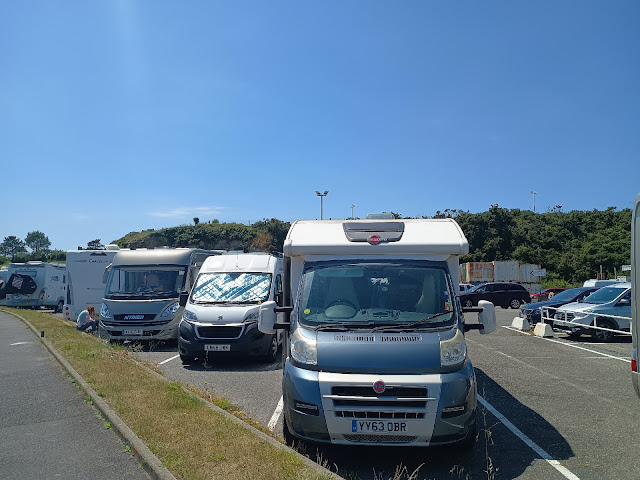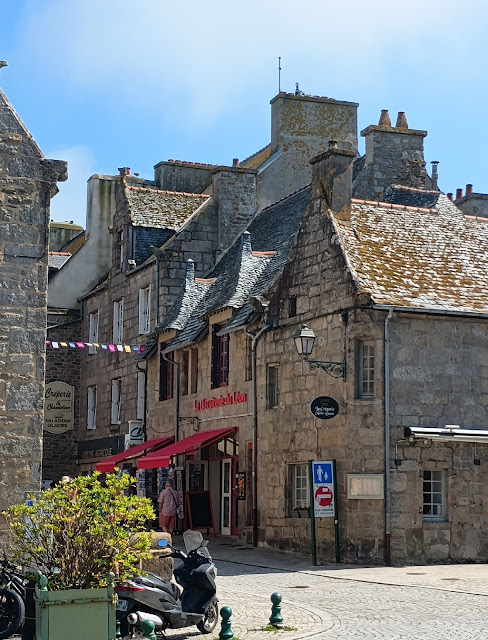As we headed north through the Vendée it became ever gloomier. By the time we reached the Nantes peripherique storm clouds were gathering. The cloud base was so low we could actually see over the hi cumulus as we topped high the arch of the viaduct over the Loire. A couple of kilometres ahead the dark sky crackled with lightning. It seemed we were headed into some horrible weather, then suddenly the storm cell dissipated as quickly as it arrived.
We found a campsite on the Vendée Brittany border. It was a bit run down, but the persistent rain didn't improve our perception of it. It poured all night. When we woke big puddles surrounded the van.
We ended up at our usual campsite and did all the usual things.
Pedalled along the coast to the Port de Trévignon to visit a great creperie we know there....
Even in familiar places you can see things anew. Brittany was our go-to summer holiday location for years. Before we had kids we explored Brittany as cycle tourists, after les enfants arrived it became a great place for a bucket and spade style family holidays, but always in late July or the first half of August.
What is different on this trip is it's a month earlier. The tussocky grass above the rocky foreshore is covered in wild flowers. Delightful!
The river is more of an extended estuary - a ria. At low tide acres of glistening mud, then in a matter of minutes the sea rushes in, filling the steep banked estuary. It's curiously mesmerising to watch.
Like most Breton towns Le Faou is built in granite. It can look quite severe, but here the buildings are embellished with fancy looking gables decorated with hanging baskets and window boxes. It gave the place a slightly Alsatian look.
The church is more typically Breton topped by an over elaborate belfry. In the seventeenth and eighteenth centuries Breton towns and villages competed to express their religious devotion by building ridiculously ornate belfries. They are all quite ghastly looking. Le Faou's is less twiddly than many.
One of the creperies in the town is reckoned to be one of the best in Brittany. Sadly it was closed so we went to another one nearby. It was pretty good too.
Locals were being very stalwart listening to the band while sheltering in shop doorways or huddled under gazebos beside the beer tent and food stalls. We weren't up for a soaking and headed back to the van.
Brittany's northern coast has many campsites; it proved difficult to decide where to stay - on the far west overlooking Oueshant, next to one of the 'abers' - Brittany's equivalent to the West Country's rias or settle down amidst the chaotic rock formations near Roscoff.
Geology won the day, so here we are camped a couple of kilometres from Brignogan Plages. Thankfully the weather has improved, a bit showery, but good enough to mooch about on our bikes exploring the wild rocky coast. There are some spectacular granite rock formations which pleased Gill immensely.
Equally pleasing are the wild flowers. Early spotted purple orchids which are a rare find in Derbyshire are ten-a-penny here. Scores of them secreted in the rock fissures above the shoreline.
We decided to use the Roscoff to Plymouth crossing. It used to be the case that it always involves an overnight journey. These days the eight o'clock morning sailing from Brittany arrives in Plymouth by mid afternoon, early enough for us to settle into the site we have booked near Lostwithiel so we can revisit the Eden Project.
Roscoff port has certainly developed since last used it over three decades ago. The place has plenty of places to park a motorhome overnight to catch the morning ferry.
In fact we arrived in the early afternoon so we were able to walk into the town - it's a couple of kilometres but once you get out of the port itself there are pavements the whole way.
Though we have been here before that was decades ago and I barely recognised the place. Despite the tourist tat the town's severe looking granite buildings speak of it's history as a gritty old port with a reputation as being the French end of the lively trade in contraband brandy that united the communities of Cornouaille and Cornwall.
They are the same people, it's obvious just looking at the place names. A few days ago we stayed at Le Faou, pronounced 'Foy', exactly the same as it's Cornish twin.
So it's Cornwall here we come. I know in the past I have mocked Brittany Ferries ridiculous styling, but their ferries are considerably more comfortable and pleasant than most. Reflecting the metrological inversion of the entire trip - dodging showers in France while England basked in sunshine- we spent a lot of the crossing relaxing on the rear deck next to the helipad.
Sunny Cornwall here we come!























No comments:
Post a Comment